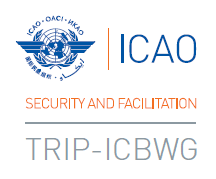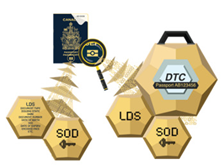

We live in a time of incredible technological innovation and digitization. Many aspects of our daily lives have been successfully digitized. Take the way we exchange and spend money. Though there was a time when we hid cash in our mattresses, in many parts of the world today, it’s actually quicker and easier to exchange money electronically. When it comes to crossing a border, why are we still so dependent on traditional paper documents to identify ourselves? Why do we still need to pull out our passport books?
A Digital Travel Credential (DTC) is a travel credential in a digital format that conforms with the specifications contained in ICAO DTC Technical Reports (and once incorporated, in Doc 9303) and are meant to temporarily or permanently substitute in a conventional passport, with a digital representation of the traveller’s identity. It is the conformance with ICAO-endorsed technical specifications which makes a DTC ICAO-compliant or not.
ICAO’s travel document experts continue to advance work aimed at making the dream of paperless travel a reality. The next logical step in this progression is the ICAO-compliant “digital travel credential,” or “ICAO DTC.” The vision for paperless travel can truly lift off with a DTC.
One of ICAO’s guiding principles in the development of an ICAO DTC has been ensuring integrity and authenticity can be validated to the same level of security as an electronic passport book (“ePassport”). Specifications for the ePassport have been available for almost 20 years – with some 150 States now issuing them, the global ePassport implementation is a model of global interoperability. There is evidence of the ePassport’s upgraded verification features being leveraged at borders throughout the world, often resulting in a far smoother experience for travellers, while not sacrificing security.
The ePassport’s upgraded verification features are enabled by the addition of an integrated circuit chip. With an ePassport, border authorities can utilize a layering of security features from both the physical booklet and the integrated circuit chip to establish confidence in the document’s issuance. The addition of the chip enables parts of this document verification process to be undertaken using fully automated means, like an automated border control – enabling new opportunities for efficiencies at border crossings.
The global rollout of ePassports has been a critical step in ICAO’s progression of work towards a globally-interoperable ICAO DTC. Returning to ICAO’s guiding principle of ensuring an ICAO DTC can validated to the same level of security as an ePassport, including its innovative layering of physical and electronic security features, ICAO has developed ICAO DTC specifications in two components – a Virtual Component (DTC-VC), and a Physical Component (DTC-PC). The DTC-VC contains the digital representation of the holder’s identity along with data verification features, while the DTC-PC is intended to ensure control with respect to accessing, and potentially unauthorized copying, of the virtual component.
Technical specifications for the DTC-VC already exist. Following their endorsement by ICAO in February 2020, they are published and available for Member States to use. This means it is possible for Member States to implement what is referred to as a “Type 1” ICAO DTC right now. For an ICAO DTC Type 1 implementation, the DTC-VC is extracted from an already-existing ePassport’s chip and shared in advance of travel. The DTC-VC can be verified independently for authenticity and integrity of data, but it remains linked to a physical ePassport (DTC-PC), which provides access and copy control.
With the exception of extraction of data from an existing ePassport, given that the existing physical ePassport is still required as the access mechanism (DTC-PC), this implementation of ICAO DTC is not overly different from how the ePassport works at borders today. If ICAO made the specification enabling this type of ICAO DTC implementation available to Member States in 2020, why are we not seeing live demonstrations of ICAO DTC? And why are we still pulling out our physical passport books when we arrive at our destinations?
New ICAO travel document specifications: building on solid tracks
It is true that the implementation of ICAO DTC by Member States has not been immediate. Historically though, this pattern for State implementation of ICAO DTC isn’t different from the roll-outs of other ICAO travel document innovations, like the globally-interoperable machine-readable passport (1980’s), and even more recently, the ePassport. In both these cases, early rollout was characterized by handfuls of early-adopters, pilot work, and lots of trial and error.
ICAO’s Traveler Identification Programme (TRIP) sets the goals and objectives of traveller identification management, leads and reinforces a global approach, and provides direction for action by ICAO, States and the many international, regional and industry partners involved in identification management. While ICAO’s TRIP work mainly targets authoritative travel document issuers, issuance is only part of the traveler identification continuum in the global context. ICAO must also consider those partners involved on the verification side of the continuum – especially given these stakeholders are the main users of whatever travel document authorities issue.
This verification side-group includes State border authorities, and extends out to a variety of other stakeholders, including contributors to traveler identification from industry. This is the group responsible for developing (or procuring) border inspection systems. Before investing, these stakeholders ideally want to know any new system will work with the majority of information being inspected, and that it will not become outdated any time soon. Perhaps most importantly, these stakeholders value the ability to establish trust in whatever information is being inspected.
This ability to verify trustworthiness is critically important as the pace of digitization increases, and as fraud becomes more sophisticated. ICAO has traditionally played an important role in ensuring global interoperability of all these aspects – by ensuring traveler identification information in a format designed to look, feel and operate the same way, and also, more recently, by building a global consensus around the underlying model to establish trust.
Setting globally-interoperable frameworks for traveler identification, and advancing globally-interoperable travel document specifications, not to mention supporting their implementation by States, is a big job. It’s challenging, and the implications are far-reaching. Thankfully, ICAO has a very good track record in addressing the needs of both the issuance and verification sides.
Let’s take a moment to look at the past fifty years of ICAO’s work advancing new innovations in globally-interoperable travel documents. In each case, like waiting for a subway to arrive at the next stop, the introduction of travel document innovation has taken some time for Member States to implement, and for global critical mass to be reached.

While global critical mass of implementations take time, the shared benefits of ICAO’s approach are proven. When ICAO endorses a travel document innovation, like those mentioned above, stakeholders like authoritative issuers and border authorities (and possibly even other verifying entities) can re-consider and possibly re-engineer their existing processes. They can do this with confidence, knowing that the rest of the world is building towards the same model. In other words – ICAO tools are scale-able, because the tracks that have been laid are solid!
 State implementation: Mind the Gap!
State implementation: Mind the Gap!
ICAO Member States make their own decisions when to implement any new travel document options. Some implementation considerations might be common across all or many States, and some to a region. Yet others will be unique to each State. These considerations determine the pace of a given State’s implementation – will it be an early adopter, or will it wait (mind the gap)?
The States choosing to adopt early are critical – they accept the risk of testing implementations of new travel document options before there is a global critical mass. Early adopters provide an invaluable service by uncovering lessons learned, which assists others in learning what works, and, perhaps even more importantly, what doesn’t.
It is also through the earliest implementation experiences that the benefits of any new innovation can be demonstrated (like efficiencies gained), which helps the whole global community to better understand and articulate those benefits in their own unique domestic circumstances.
For other States, “mind the gap” may apply. ICAO recognizes each State is at its own unique stage in implementing the globally-endorsed traveler identification model. One State might not be issuing an ePassport. Some might be issuing ePassports, but not yet leveraging ePassport chips at their borders. Other States might not be in positions to prioritize travel document issuance and verification at all.
There could be valid national considerations at play for each of these scenarios. For States choosing to wait, there is nothing wrong with “minding the gap”. Even with the newest innovations like ICAO DTC, ICAO always considers the need for global backwards compatibility, and it is anticipated the physical passport book will still be in active use for the foreseeable future. Additionally, those who wait can benefit from the lessons learned from others in the global community.
ICAO DTC: The tracks have been laid and are proven to work
While we do not yet know what a reasonable ICAO DTC implementation timeline will be for States, it is believed uptake may occur more quickly than previous transformation. That is because ICAO DTC is based on already-proven, globally-interoperable concept – the ePassport.
Globally, some 20 years after its introduction, most States have made (or are making) investments in ePassport issuance and verification. In doing so, these States are also laying the tracks for future ICAO DTC implementation. Why? Because the transition from traditional machine-readable passports to electronic passport was a big leap!
To properly issue an ePassport, a State must not only ensure compliance of the physical document to ICAO specifications, but also ensure compliance of the passport’s chip. The addition of the chip requires States to build new domestic technical capacities for both issuance and verification. Moving from machine-readable (only) to electronic passports requires a learning curve – but, once that transition is made, a State will have laid the “tracks” on which to consider future ICAO DTC implementation.
So…is it possible we’re closer to a world of paperless travel than we thought?
Helping ICAO Member States to “Mind the Gap”
Following the introduction of a new travel document option or innovation, ICAO has learned the value of getting implementation guidance for States out as early as possible. This means working closely with early adopters as they implement – something which ICAO, by creating a forum for discourse on early adopters’ experiences – can support. ICAO can also help ensure early adopters’ experiences and lessons-learned are proactively communicated to the whole global community. Finally, ICAO can convene the right people to consider those early experiences, and develop baseline guidance, best practices, and where necessary, identify challenges and suggested mitigation strategies for all Member States.
 ICAO’s Implementation and Capacity Building Working Group (ICBWG) has the mandate of supporting ICAO in achieving its TRIP-related security and facilitation related objectives via various activities, including the development of guidance material and tools to assist with implementation of TRIP-related standards, recommended practice and specifications.
ICAO’s Implementation and Capacity Building Working Group (ICBWG) has the mandate of supporting ICAO in achieving its TRIP-related security and facilitation related objectives via various activities, including the development of guidance material and tools to assist with implementation of TRIP-related standards, recommended practice and specifications.
The ICBWG is committed to developing implementation guidance for Member States supporting roll out of ICAO DTC. This work will build on existing policy (set by ICAO’s New Technologies Working Group/NTWG), as well as existing use cases and FAQ’s. The objective is to develop guidance that will not just raise awareness of and guidance for ICAO DTC, but also to capture lessons learned from the various live pilots of ICAO-compliant DTC underway.
We want your State’s contributions!
Given the ICAO DTC is in the very earliest stages of being implemented, so too is the ICBWG’s work on the supporting implementation guidance for states. Guidance work is expected to ramp up in 2024.
Interested in helping the global community get closer to the reality of paperless travel? Make your voice heard! Whether your State is among the early ICAO DTC adopters or among those choosing to “minding the gap”, if you are interested in supporting the ICBWG’s work in development of ICAO DTC implementation guidance for the global community, ICBWG wants to know – please email here.
Any new travel document model, especially an innovative concept like ICAO DTC, takes time to gain global traction. However, thanks to global implementation of ePassport, States can make their considerations around ICAO DTC implementation knowing the supporting tracks are established, and are proven to work.
Moreover, States can count on ICAO continuing to play its role of ensuring the whole global community is well-informed, and also, in ensuring that the experiences of early adopting ICAO Member States can serve to benefit all other Member States. This is exactly the intent behind ICBWG’s ICAO DTC Implementation Guidance exercise.
The post Mind the Gap: Supporting Global ICAO Digital Travel Credential Implementation appeared first on Uniting Aviation.
Discover more from reviewer4you.com
Subscribe to get the latest posts to your email.




